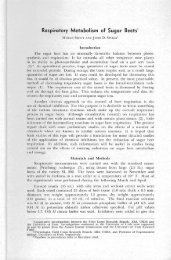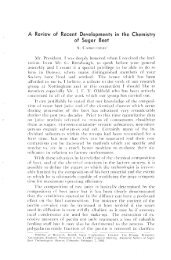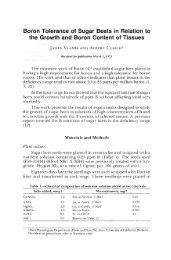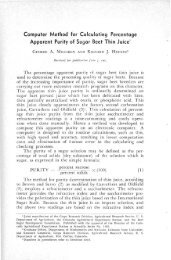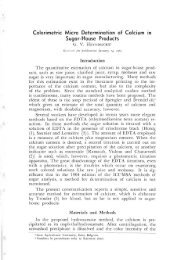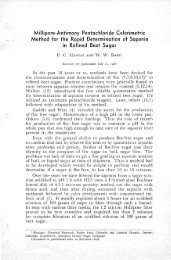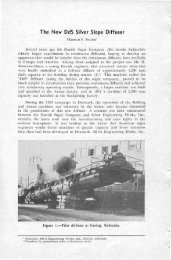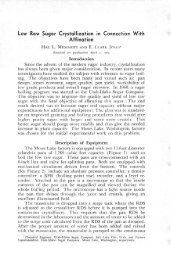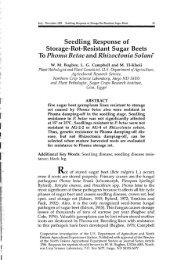Journal of Sugar Beet Research - Vol
Journal of Sugar Beet Research - Vol
Journal of Sugar Beet Research - Vol
Create successful ePaper yourself
Turn your PDF publications into a flip-book with our unique Google optimized e-Paper software.
32 <strong>Journal</strong> <strong>of</strong> <strong>Sugar</strong> <strong>Beet</strong> <strong>Research</strong> <strong>Vol</strong>. 45 Nos. 1 & 2<br />
Storage <strong>of</strong> sugarbeet in piles is common in production areas with mild<br />
climates, which allows the factory campaigns to be longer and more<br />
productive. However, sucrose loss occurs during this storage period.<br />
Harvest practices, respiration rates, storage rots, and weather conditions<br />
during and after harvest influence the storability <strong>of</strong> sugarbeet (Bugbee,<br />
1993; Jaggard et al., 1997). The respiration required to maintain a viable<br />
root, may account for 50-60% <strong>of</strong> the total sucrose loss (Wyse and Dexter,<br />
1971). On the outer 60 cm <strong>of</strong> piles, dehydration is a major cause <strong>of</strong> sucrose<br />
loss (Bugbee, 1993). Once weight loss in a beet exceeds 25-30%, the root<br />
can no longer resist microbial development (Bugbee, 1993). Storage rot<br />
pathogens such as Phoma betae Frank, Botrytis cinerea Pers. ex Fr., and<br />
Penicillium claviforme Bainier also cause important sucrose losses in storage<br />
(Bugbee, 1982). In Moorhead, MN, a survey <strong>of</strong> beet coming into the<br />
factory from storage piles determined that 1.2% <strong>of</strong> the tissue was rotted<br />
(Bugbee and Cole, 1976). This amount <strong>of</strong> rot may seem small but led to<br />
a loss <strong>of</strong> 500 t <strong>of</strong> sucrose daily and another 800 t lost indirectly because <strong>of</strong><br />
impurities (Bugbee and Cole, 1976). Air flow and temperature control are<br />
also important in managing sucrose losses in storage piles (Bugbee, 1993;<br />
Peterson et al., 1980; Wyse, 1978). Diseases in the field may also influence<br />
storability (Campbell and Klotz, 2006; Campbell et al., 2008; Kenter<br />
et al., 2006; Smith and Ruppel, 1971; Strausbaugh et al., 2008).<br />
Curly top is a widespread problem in sugarbeet in semi-arid areas <strong>of</strong><br />
the United States. Curly top on sugarbeet is caused by <strong>Beet</strong> severe curly top<br />
virus or a number <strong>of</strong> closely related species transmitted by the beet leafhopper,<br />
Circulifer tenellus (Baker) in a circulative-nonpropagative manner (Soto and<br />
Gilbertson, 2003; Stenger, 1998; Strausbaugh et al., 2007). Curly top nearly<br />
eliminated the sugarbeet industry in the western U.S. until cultivars with resistance<br />
became generally available (Bennet, 1971; Blickenstaff and Traveller,<br />
1979). Control <strong>of</strong> this disease is still largely based on host resistance.<br />
Insecticides including seed treatments such as clothianidin may also reduce<br />
curly top damage (Strausbaugh et al., 2006). However, even the combination<br />
<strong>of</strong> host resistance and insecticidal seed treatment (Strausbaugh et al., 2006;<br />
Strausbaugh et al., 2007) does not keep plants virus free. Therefore, studies<br />
were conducted to investigate the influence <strong>of</strong> curly top, host resistance, and<br />
insecticide seed treatments on the storability <strong>of</strong> sugarbeet.<br />
MATeRIALS AnD MeThoDS<br />
Treatments.<br />
The study contained six treatments consisting <strong>of</strong> three commercial<br />
sugarbeet cultivars with and without Poncho Beta (clothianidin 60 g<br />
a.i./100,000 seed + beta-cyfluthrin 8 g a.i./100,000 seed). The study was



